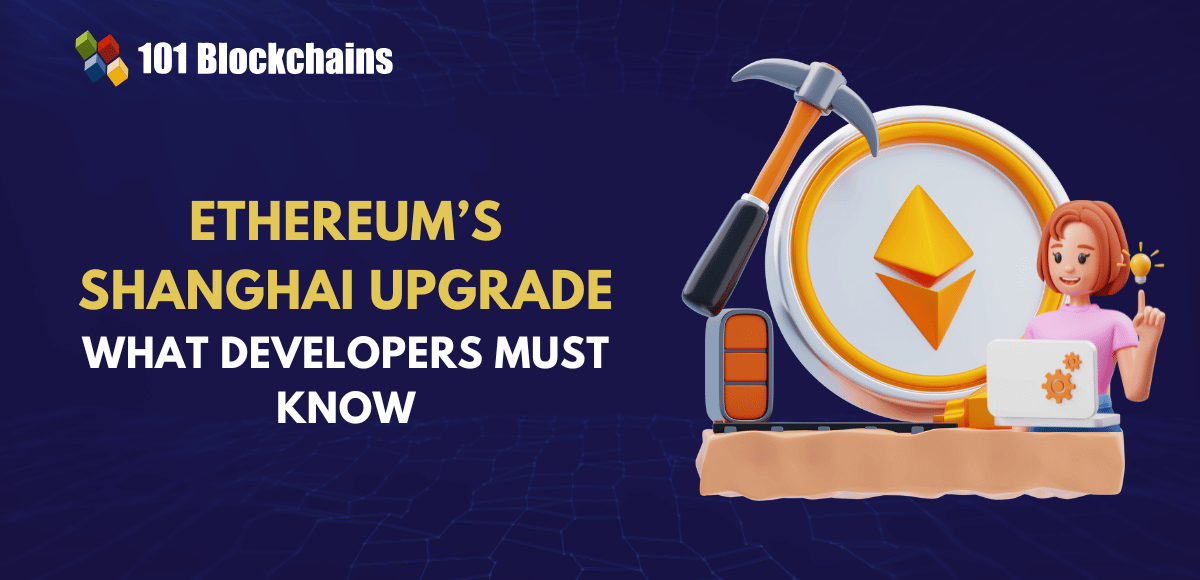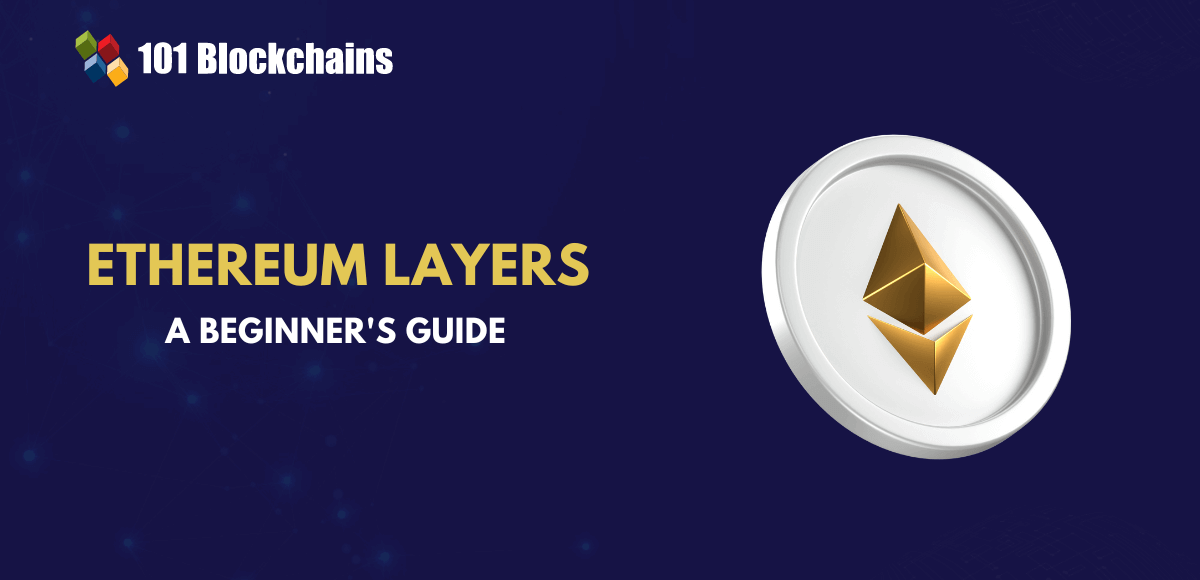Learn how blockchain truly works, master key definitions, and uncover what makes smart contracts so "smart." Dive into the fundamentals, gain valuable insights, and start your blockchain journey today!

- Ethereum
James Howell
- on February 03, 2023
What Is Wrapped Ethereum and How Does It Work?
The cryptocurrency market has been experiencing periods of volatility since the inception of decentralized virtual currencies. Bitcoin and Ethereum are the two biggest names to look up to in the crypto landscape right now. However, multiple cryptocurrencies have emerged, thereby ensuring the expansion of the crypto market by significant margins. Traders must have come across the term Wrapped Ethereum or WETH on certain platforms.
The origins of WETH are associated with the ERC-20 standard, which ensures flexibility, transparency and practical outcomes. Different types of crypto exchanges, decentralized apps, and wallets offer native support for ERC-20 tokens. On the other hand, Ether is not compatible with ERC-20, thereby limiting the use of Ether for exchanging ERC-20 tokens or vice-versa.
The use of ERC-20 tokens in emerging dApps requires a seamless exchange of ETH for ERC-20 tokens. Therefore, Wrapped ETH offers a solution to this problem by enabling seamless interoperability with ERC-20 token standards. The following discussion offers you a detailed introduction to WETH and how it works.
Excited to build your skill in Ethereum development by leveraging the ethers.js library? Enroll Now in Ethers.Js Blockchain Developer Course!
Ethereum and Smart Contracts
The foremost concepts in a guide on wrapped Ethereum explained in detail would emphasize Ethereum and smart contracts. Ethereum is a distributed computing platform with the EVM helping developers create dApps for various use cases. Most the developer use Ethereum for the power of smart contract development. Smart contracts are self-executing programs that have the terms and rules encoded on the blockchain.
Smart contracts offer a new approach to ensuring immutable, automatic and traceable transactions on blockchain networks. When specific conditions for a transaction are fulfilled, the smart contract is triggered, and it completes the transaction according to pre-defined parameters.
Now, smart contracts have to evolve as new use cases of blockchain garner the attention of tech communities. Therefore, the new Ethereum standards define new scripting standards for supporting the emerging use cases for dApps. You can find the answer for ‘what is wrapped Ethereum’ in the fact that Ether does not support every dApp or smart contract on Ethereum. Smart contracts serve as the core element of dApps, which operate DeFi solutions on Ethereum blockchain. ETH is the primary requirement for the operations of dApps and smart contract deployment on the blockchain. As new smart contracts follow new standards such as ERC-20, it is difficult to use ETH for them.
Understand the complete smart contract development lifecycle with the Truffle framework by enrolling in the Smart Contracts Development.
What is Wrapped Ethereum?
The question presents a vital solution to the problem of interoperability between ETH and ERC-20 smart contracts. As the name implies, wrapped ETH is a wrapped version of Ether, the native token of Ethereum blockchain. The basic explanation of WETH suggested that it is nothing else but Ethereum, which has been ‘wrapped’ in compliance with ERC-20 token standards. Wrapped tokens and coins like WETH have the same value as the underlying asset i.e., ETH.
One of the first concerns of any individual regarding Wrapped Ethereum uses would revolve around the credibility of wrapped tokens. With respect to the pricing of Ethereum, WETH is safe as its price is the same as that of Ethereum. The price peg between WETH and ETH is 1:1, thereby implying that both of them are similar in value. Wrapped tokens are different from the underlying asset only in terms of use cases.
As a matter of fact, Bitcoin also has a wrapped variant known as Wrapped Bitcoin, pegged at a 1:1 ratio with Bitcoin. You can assume that wrapped tokens are practically similar to stablecoins, as stablecoins also have the same value as underlying assets. Just like redeeming stablecoins for fiat currencies, you can also ‘unwrap’ tokens at any time.
Learn the basic and advanced concepts of Ethereum and understand how to get started developing with Ethereum by enrolling in the Ethereum Development Fundamentals.
Reasons to Wrap Ethereum
Another important highlight in a guide on ‘how wrapped Ethereum works’ would also point at reasons for wrapping Ethereum. Beginners would have doubts about the need for the wrapped version of Ether when you can use ETH on the Ethereum blockchain. The best way to understand the reason behind wrapping Ethereum would refer to the technical differences in the design of Ethereum tokens.
Ethereum network helps developers in creating new rules and standards for fuelling the crypto sector. For example, the ERC-721 token standard has emerged as a prominent highlight for NFT development. Therefore, the ERC-721 tokens would behave differently in comparison to the ERC-20 tokens and ETH.
While developers have the flexibility for customization to create digital assets, ETH cannot be utilized in all dApps. Considering the use of dApps for accepting ERC-20 tokens in investment and staking applications, it is important to seek ways to use ETH. The benefits of an ERC-20 token version of Ether offer answers to “What is wrapped ETH used for?” when you can use WETH for adding Ether to a liquidity pool or using it as collateral. The most significant benefit of wrapped tokens is the seamless interoperability of tokens throughout the blockchain ecosystem.
Working on Wrapped Ethereum
The fundamentals of wrapped tokens provide a clear impression of the stability of wrapped Ethereum price estimates. Interestingly, the process of wrapping and unwrapping tokens is simple, thereby ensuring faster transactions. Wrapped tokens have been tailored to resolve the problems of interoperability evident in most blockchains. For example, users could not utilize ETH on the Bitcoin blockchain. Wrapping helps in the tokenization of cryptocurrencies alongside wrapping them with the token standards of a specific blockchain. As a result, a specific cryptocurrency could serve use cases on another blockchain network.
One of the foremost aspects of Wrapped Ethereum would point to the fact that it is not useful for paying gas fees in Ethereum blockchain transactions. However, it can leverage ERC-20 compatibility for offering investment and staking opportunities on different DeFi apps. WETH could also serve as useful for purchasing and selling NFTs through auctions on the OpenSea marketplace.
The working of WETH involves sending Ether to a smart contract, which would generate WETH. At the same time, users have to lock ETH, thereby ensuring that the wrapped Ethereum has the backing of an Ethereum reserve. When you unwrap or exchange the WETH back into Ether, you have to burn or remove the converted WETH from circulation. This helps in ensuring that the wrapped token price remains at the same peg as the value of the underlying asset at all times. Crypto users can also access WETH by swapping other tokens on crypto exchanges such as Uniswap or Sushiswap.
Learn comprehensively about the working of Ethereum by enrolling in the Complete Ethereum Technology Course.
Is Wrapped Ethereum a Replacement of Ether?
The explanation for ‘how does wrapped Ethereum works’ shows how wrapped tokens can serve an important role in the future of smart contract development. As a matter of fact, the primary objective of WETH focuses on updating the Ethereum codebase to ensure ERC-20 compliance. In the long run, WETH aims to remove the need for wrapping ETH, thereby achieving complete interoperability of Ether.
Now, WETH serves a significant purpose in facilitating liquidity to liquidity pools alongside other applications such as NFT and crypto trading. Therefore, wrapped Ether is more like a temporary solution rather than a replacement of ETH on the Ethereum blockchain. Considering the long list of upgrades planned for the future of the Ethereum blockchain, interoperability will no longer pose a credible concern.
Methods for Wrapping Ether
The basics of wrapped Ethereum explained the necessity for using them in the existing decentralized ecosystems. How can you wrap Ether? You can find different tools for solving this question. The most common response for wrapping ETH would point to sending it to smart contracts. On the other hand, you can also swap another token for WETH on crypto exchanges. Here are some of the popular methods for wrapping ETH.
- Wrapping ETH on OpenSea
- The OpenSea NFT marketplace offers you a reliable platform for converting Ether into wrapped ETH with the WETH smart contract.
- You can start the process by clicking on the “Wallet” option at the top-right corner of the OpenSea app.
- Now, click the three dots near the Ethereum option, followed by selecting ‘Wrap.’
- In the next step, input the amount of ETH you want to convert into wrapped Ethereum with OpenSea.
- Click the ‘Wrap ETH’ button to call the WETH smart contract for converting ETH into wrapped Ether.
- You will find a MetaMask pop-up seeking the user’s signature for the transaction.
- After completion of the wrapping process, users would receive a confirmation message.
Finally, you can find the wrapped ETH balance in the OpenSea account wallet. Users can identify WETH with the pink Ethereum diamond, which is a distinctive highlight in comparison to Ether.
Upgrade your knowledge of Ethereum and understand the concepts of Ethereum with the Ethereum Flashcard.
Creation of WITH through Uniswap
The discussions on ‘what is wrapped Ethereum’ also point to methods for wrapping Ether tokens with Uniswap. Here are the steps for obtaining wrapped Ether through Uniswap.
- The first step involves connecting your wallet to the Uniswap exchange and selecting the Ethereum network on the Uniswap platform.
- You have to click on the ‘Select Token’ option at the bottom field, where you can select wrapped ETH from the multiple lists of options.
- Now, enter the amount of Ether you want to convert into WETH and then click on the ‘Wrap’ option.
- In the next step, users have to confirm the transaction from their wallet by paying gas fees in ETH.
After confirmation of the wrapping transaction by users, they can wait for the final transaction confirmation on the blockchain.
Generate WITH with MetaMask
The MetaMask crypto wallet is also another tool for creating wrapped Ethereum with a few simple steps. Here are the important steps for creating WETH on MetaMask.
- Choose the “Ethereum Mainnet” option on the MetaMask wallet extension.
- Click on the “Swap to” field and choose WETH.
- Input the amount of ETH you want to convert into WETH, and then click on the “Review Swap” option.
- You would find a window showcasing the conversion rate for the wrapping process. The conversion of ETH to WETH implies that the conversion rate would be 1:1.
- After confirming details of ‘how wrapped Ethereum works’ and the conditions of the swap, you can click on the “Swap” option.
Users can notice the WETH balance in their MetaMask wallet after confirmation of the wrapping transaction.
Develop an in-depth understanding of blockchain fundamentals by enrolling in the Crypto Fundamentals, Trading, And Investing course.
Methods for Unwrapping ETH
The response to “What is wrapped ETH used for?” indicates the interoperability of Ether with other blockchain networks. Interestingly, the simple methods for wrapping ETH point to the efficiency of achieving interoperability effectively with wrapped tokens. At the same time, you must also notice the ease of methods for unwrapping tokens. Most important of all, you don’t have to learn any different approaches for token unwrapping. For example, you can use the same methods for swapping WETH into ETH by interacting with smart contracts like the ones you used for wrapping tokens.
In the case of the OpenSea platform, you have to choose the “Unwrap WETH” option instead of “Wrap ETH” option for unwrapping WETH tokens. You can apply the same logic for unwrapping wrapped ETH on Uniswap and MetaMask through exchanges. The process for unwrapping on these two platforms is exactly the same as wrapping ETH to WETH, only with the values interchanged. Users can also rely on other crypto exchanges, such as Binance, for converting WETH into ETH. The Binance Convert & OTC Portal offers a convenient interface for the conversion of cryptocurrencies.
Can You Access Wrapped Tokens for Ethereum Only?
No, wrapped tokens are not exclusive to Ethereum only, as you can learn from the example of Wrapped Bitcoin. In addition, it is possible to use wrapped Ether on different blockchains other than Ethereum. The benefits of wrapped Ethereum uses are evident in the benefits of interoperability, better liquidity, and capital efficiency in the crypto landscape. Wrapped tokens serve the exact purpose of stablecoins like wrapped versions of fiat currencies.
Similarly, wrapped Ether can allow traders to use ETH to the Binance Smart Chain, thereby enabling access to the BSC DeFi ecosystem. You can also consider using wrapped tokens with a bridging service for minting wrapped tokens by storing underlying assets on the origin blockchain. However, it is important to verify the credentials of the platform before using the crypto bridges, owing to security concerns.
The credibility of Using Wrapped Tokens
The detailed introductory guide on WETH and “What has wrapped ETH used for?” must also highlight the concerns in using wrapped tokens. One of the biggest setbacks of wrapped tokens is the susceptibility to centralization. As of now, wrapping processes for tokens are not Turing-complete and could not achieve automation through the Ethereum blockchain. The involvement of centralized platforms in the wrapping process creates possibilities for abuse and manipulation.
However, wrapped tokens present the foundations for a future where all blockchains would be compatible with each other, thereby offering a truly decentralized ecosystem. Wrapped tokens could help in strengthening stability in interactions between different blockchains alongside facilitating cross-chain atomic swaps.
Familiarize yourself with the second-most-popular blockchain network through Ethereum Skill Path
Final Words
The introduction to wrapped Ethereum explained the basic design of wrapped tokens and the processes to create them. Wrapped Ether is practically ETH token suitable for working with other blockchain networks or token standards. The continuously evolving array of token standards has ensured new value benefits for smart contract and dApp developers.
However, the lack of interoperability between conventional crypto assets and emerging web3 use cases such as NFTs and DeFi applications presents vital concerns. The use of wrapped tokens like WETH can offer reliable solutions to interoperability issues alongside adding improved liquidity in the crypto landscape. Learn more about wrapped tokens and cryptocurrency fundamentals in detail now.
*Disclaimer: The article should not be taken as, and is not intended to provide any investment advice. Claims made in this article do not constitute investment advice and should not be taken as such. 101 Blockchains shall not be responsible for any loss sustained by any person who relies on this article. Do your own research!





